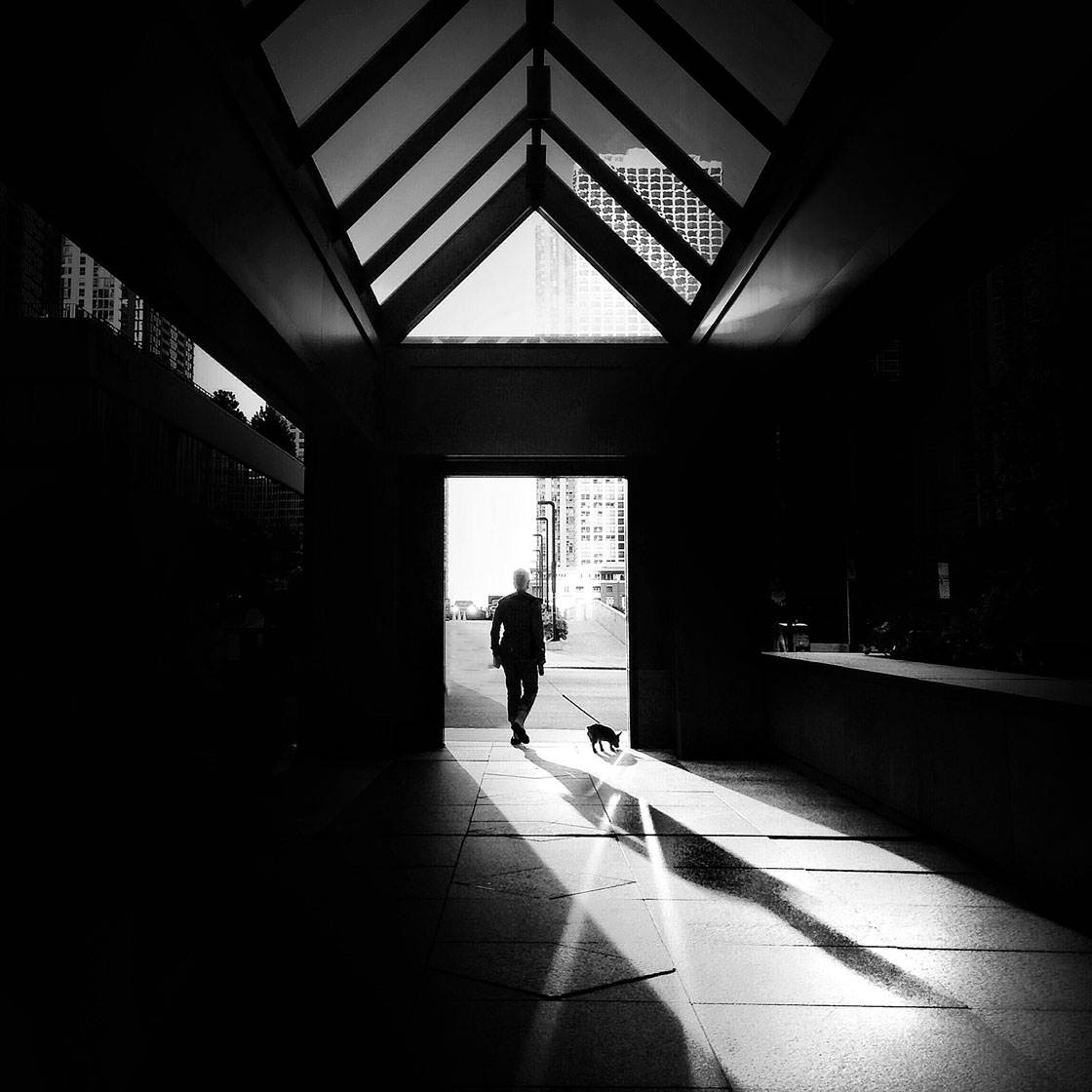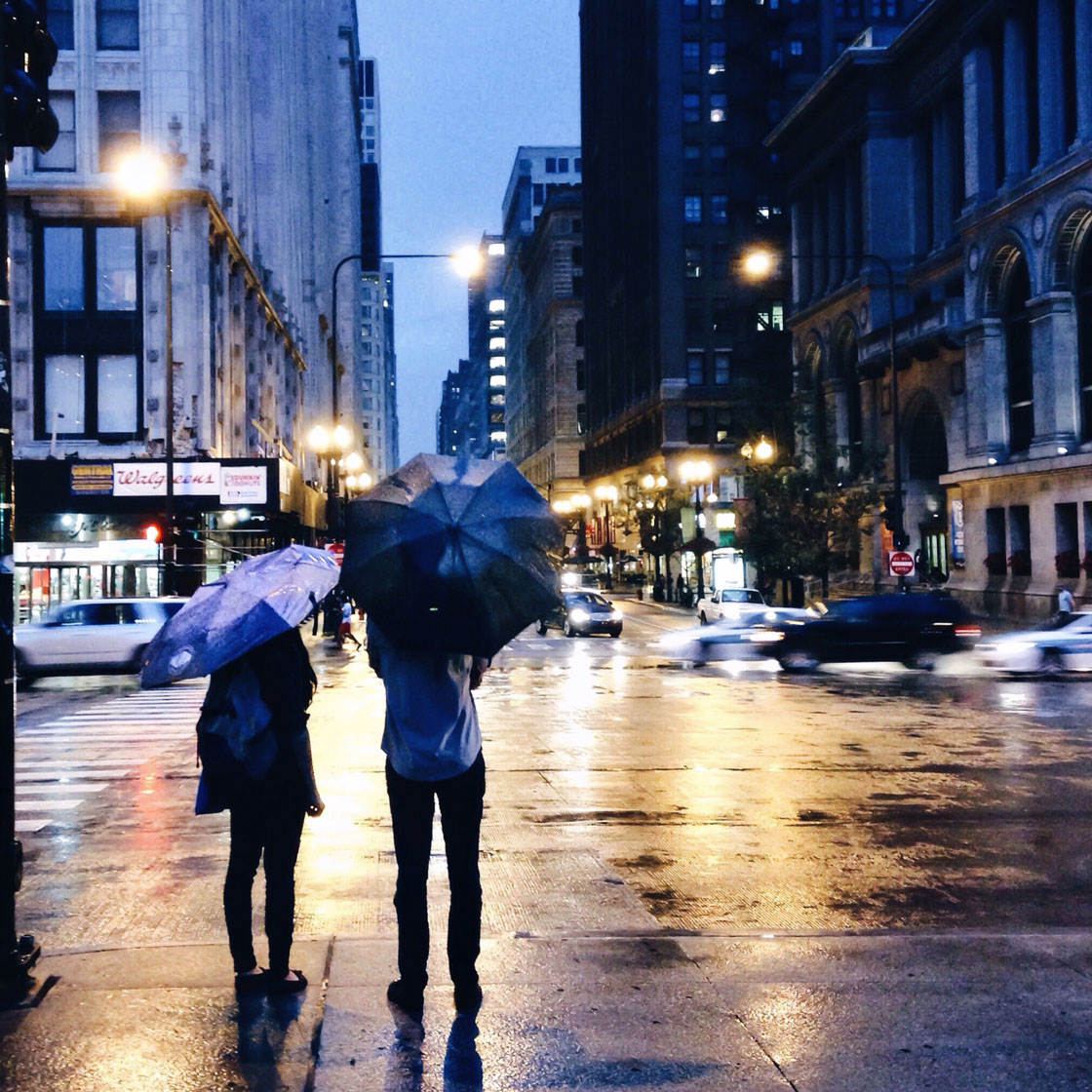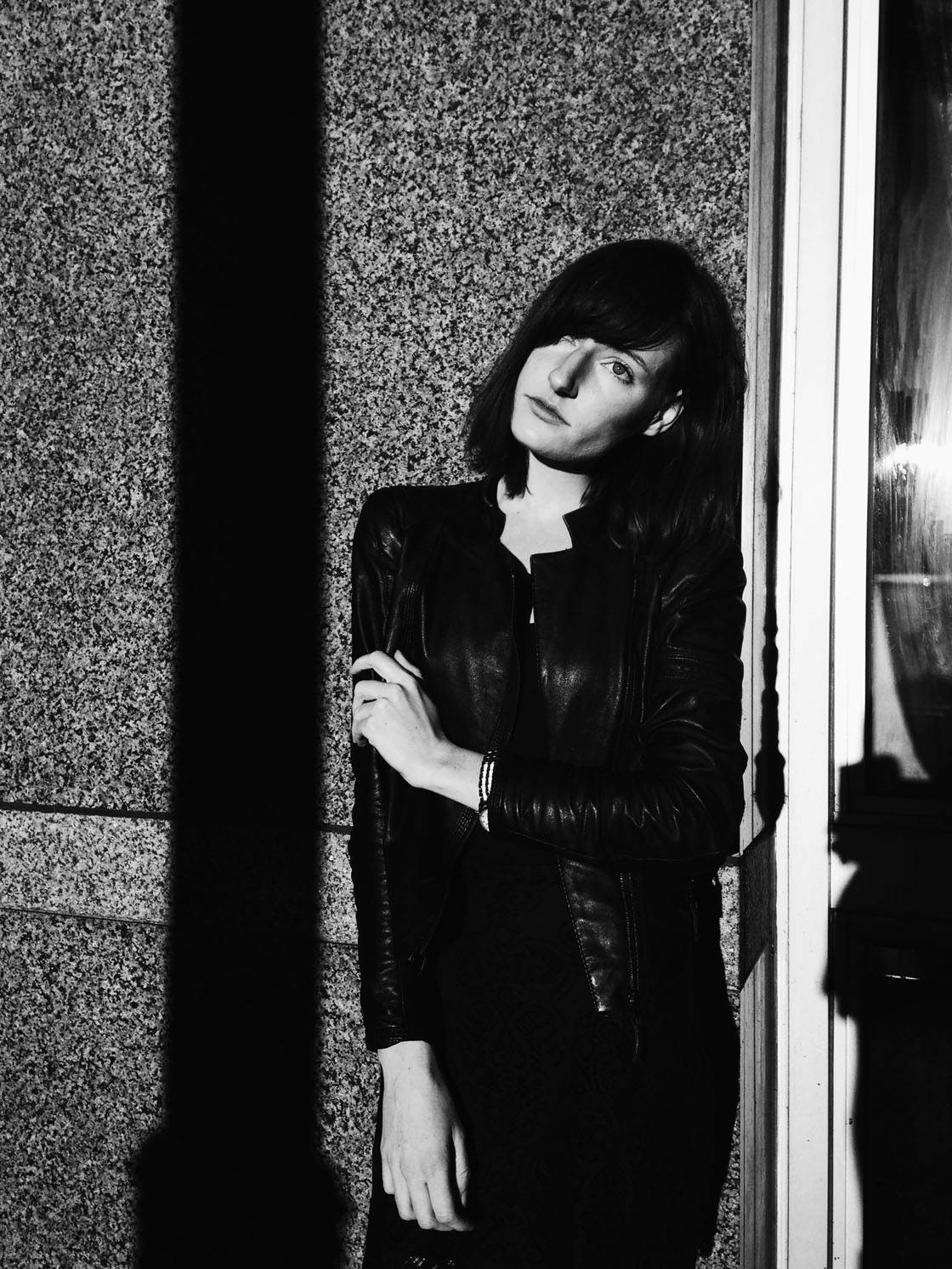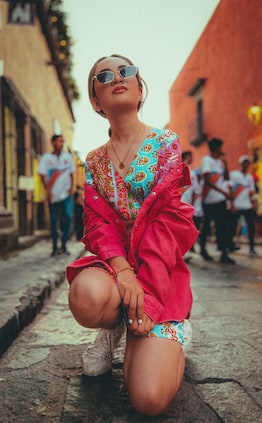Street photography is one of the most fascinating and powerful forms of storytelling. Its power comes through capturing a combination of elements such as a person, weather, mood and lighting that can never be replicated again. In this tutorial, you’ll discover eight street photography storytelling tips for powerful and intriguing photos.

1. Be Discreet
Try to go unnoticed as much as possible when shooting street photography. In most cases, if your subject is aware that you’re taking their photo, they’ll change their behavior and the story you wanted to tell will be gone.
Being discreet allows you to capture people being their natural selves within a city environment.

Luckily, the small size of the iPhone makes it easy to be stealthy while attempting to take a photo. But there are certain ways to make sure you go unnoticed.
One technique is to photograph your subjects from behind so that they don’t see you. This also allows you to preserve the anonymity of the people you’re photographing.

Rather than standing in the middle of the street taking photos, hide away in the shadows or sit down on a bench.
Keep your iPhone close to your body rather than shooting with your arms out in front of you. Holding the phone in vertical orientation will make it less obvious that you’re taking photos.

Another way of shooting without drawing attention to yourself is to pretend you’re listening to music with your earphones plugged in while holding your phone.
The volume button on the headphones can be used as a shutter release so that you don’t have to tap the screen to take a photo.
2. Watch For Interactions Between People
Photographing interactions between people on the street is a great way to tell interesting stories that will capture the viewer’s imagination.

Look out for people having conversations, meeting and greeting each other, holding hands, or interacting in some other way.
It’s easy to catch people having conversations in the morning before work, on a lunch break in front of office buildings, and at recreational spaces like parks.

These interactions will get the viewer’s mind going, making them intrigued about what the people were talking about or why they were meeting.
Some of these interactions may be very brief, so be sure to use burst mode to capture moments like people hailing a cab or shaking hands as they meet.

To activate burst mode, simply hold down the shutter button in the camera app to fire off a series of shots in quick succession.
The most powerful aspect of storytelling is that a viewer may relate to the photo in many different ways other than the intended caption.

So remember that your job is to capture a moment in a photo, but the viewer gets to interpret it in their own way.
3. Isolate The Subject
A typical street scene is often busy, so it’s really hard to focus on a subject when the rest of the scene is distracting.
Isolating your subject from their busing surroundings will create a stronger subject and give an overall powerful visual impact to the story.

A great strategy is to find a good location like a wall or building facade, and then patiently wait for someone to appear in the frame.
Try to capture them in a position where they’ll be most visible. For example, if they’re wearing dark clothing, capture them against a bright part of the background, and vice versa.
Another option is to get to a high vantage point and shoot down at the ground in order to capture a subject without any of their distracting surroundings.

Generally, periods before rush hour or on weekends in certain parts of the city might be less busy, making it easier to isolate the subject from their surroundings.
Try to get an idea of when your city is less busy so that you can go out to shoot at these times.

Even at busy times of the day, it’s possible to isolate subjects during small windows of opportunity, such as when people are crossing the road.
Another great way of isolating subjects in a busy scene is to take advantage of lighting. In certain instances, harsh sunlight can cast dark shadows which can often hide other people who are walking within the frame.

Even if they’re visible in the original capture, a bit of photo editing can easily eliminate the distracting figures within the dark shadows of the scene.
4. Capture Facial Expressions & Emotions
Capturing the facial expressions, body language and emotions of your subjects will go a long way towards helping you tell a particular story in your street photography.
For example, is your subject happy, excited, sad, angry, frustrated, bored, etc?

To capture facial expressions you need to get quite close to the subject. This can be difficult to do in candid street photography as you have to maintain a balance between being discreet and keeping a good distance.

Try to capture your subject just as they walk past you, or when you’re sitting on public transport for the best chance of getting a close-up shot.
Alternatively, if you meet a stranger on the street and start up a conversation with them, they might agree to pose for you if you ask politely.

Another non-candid way is to simply stage a shoot with a friend on the streets. In the photo above, there’s enough body language to bring this photo to life.
5. Capture The Daily Commute
People are constantly on the go in street photography. You’ll often find people walking, running, sitting, cycling, or waiting as part of their daily commute.

There’s a lot of action to be photographed, especially when people are crossing the streets.
You’ll often find people on their phone or listening to music while they’re walking. Watch for interesting body language, interactions and moments, and be ready to capture them with your iPhone.

Use burst mode to fire off a series of shots in order to get at least one photo with the subject in the perfect position and stride. You can easily delete the other unwanted photos after.
Make sure you hold down the shutter button to activate burst mode just as the subject enters the frame, and don’t stop shooting until they’ve gone.

Another great place to capture the daily commute is on the subway – both on the platforms and on the trains.
Here you’ll capture all sorts of interesting moments and interactions. I especially like to photograph the energy and atmosphere of street performers in these locations.

6. Take Photos At Events
Be on the lookout for interesting events happening in the community. Protests, sporting events, marathons, parades and carnivals are perfect opportunities to capture incredible storytelling moments.

Each event will have a different atmospheric feeling that you can capture in your photos to tell a particular story.
For example, at a protest you may capture sadness, frustration or anger. At a holiday parade you’ll capture a different type of energy amongst the crowd.
Sporting events are another great place to photograph crowds of people and emotional moments.

In the photo above, even though it’s a busy scene, the crowd adds an extra storytelling element to the image.
7. Venture Out In Bad Weather
Rain and snow provide great opportunities to capture the atmosphere of the city and tell a profound story, especially when there are people in the frame.

Look out for umbrellas as their bold colors and geometric shapes will add a strong focal point to your composition.

On rainy and snowy days, couples often tend to huddle together under umbrellas. Capturing these moments can add a romantic and atmospheric feeling to your photos.

Watch how people act differently in bad weather, for example, rushing to get out of the rain or having fun in the snow with friends.

Capture these moments to tell a story of the weather in the city on that particular day.
On a rainy day I love to shoot through raindrop-covered windows at bus stops and coffee shops.

This adds wonderful visual interest to your photo and really conveys what the weather was like.
8. Capture Silhouettes & Shadows
Part of storytelling in photography includes creating a cinematic atmosphere.
Silhouettes and shadows are perfect because they add a sense of mystery and drama to your photos.

They make the viewer more intrigued about what’s hiding in the darkness. Anything that intrigues the viewer and makes them ask questions will make your story more powerful.

Using shadows to create negative (empty) space in a scene adds an intense atmosphere where the viewer becomes aware of the depth and scale of the surrounding area.
To create silhouettes and shadows you need a strong light sources such as harsh sunlight.

Look out for interesting shadows cast by the architectural elements around you, then capture a person as they walk into the illuminated part of the scene.
During the golden hours of sunrise and sunset when the sun is low in the sky, you’ll be able to capture wonderful long shadows.

To create a silhouette, the light source must be behind the subject. After tapping to set focus, swipe down on the screen to reduce the exposure until the subject appears as a dark outline against the brighter background.

Conclusion
Storytelling is all about living in the moment and being quick enough to capture the interactions and emotions of your subjects. It also requires you to be patient, waiting for just the right moment that will tell an interesting story.

To capture people in their most natural state, try to be discreet. Once they become aware that you’re taking their photo, the moment you wanted to capture will probably be lost.

Remember that light and weather will have a big impact on the atmosphere of your photos. So make use of shadows, silhouettes and bad weather conditions to add drama and mystery to your images.



Thank you again Emil – wonderful ideas and inspriations
I’m happy to hear that you found this article inspiring, Eileen. 🙂
Emil, I do love the fact that after taking your iPhone Photo course, you still continue to send superb further tutorials. Gives taking the course to be wonderful value. Keep up the good work
Thank you for saying that, George. 🙂 We’re constantly trying to provide our students with valuable information!
Thank you for your time sharing this tutorials.
Are there no legal requirements to taking street photos with people in them? Do you not need model releases?
Hi Kate. In most countries if you’re shooting in a public place you don’t need a model release – unless you’re using the photo for commercial purposes. Of course, it would always be wise to check the rules for the particular country that you’re shooting in.
Awesome pics
Glad you enjoyed them George 🙂
I look forward to every “how to” article you send our. They are informative & have led me to discover things about iPhone I never knew. We’re leaving I two days for Quebec & I am seriously considering leaving my large Nikon home $ just using my phone.
So pleased to hear that our tutorials have helped you with your iPhone photography. I haven’t taken my DSLR on holiday for many years now – I always just use my iPhone! 🙂
Always enjoy learning and/or being reminded on good techniques. Great article with wonderful examples. Thank you many times???
Glad you found this article helpful Arline 🙂
would you like to comment on the use of the square format as used in this lesson?
use
I enjoy your iPhone tips & tutorials and have learned so much.
Wonderful information. Thank you so much! Love your photos as well.
So glad to hear that these tips and photos are helping you with your iPhone photography 🙂
Great photos. Very impressive and inspiring
Thanks! Glad you enjoyed them 🙂
After reading this tutorial (and others) I have to agree with Lilian Canson, George and all the others. Thank you for your time and keep up the good work.
Really enjoyed this. Gives me a buzz. Also relived a great holiday. Must do it again…properly.
Glad to hear you enjoyed this tutorial Lyn 🙂
i love this article and think the photos are great but how do you take these great photos?